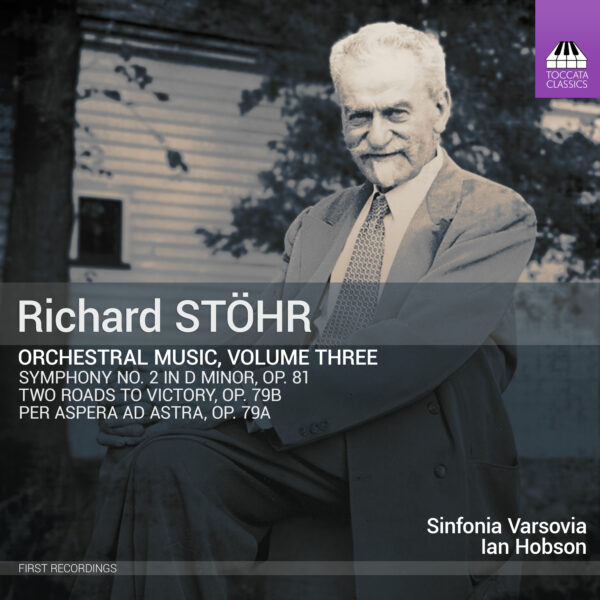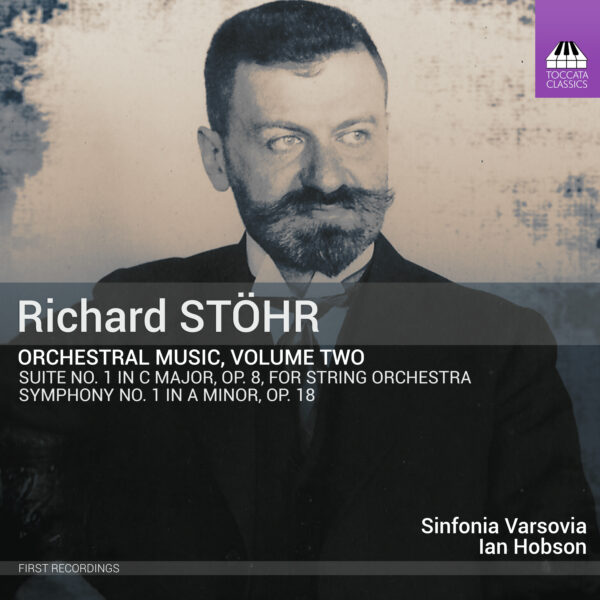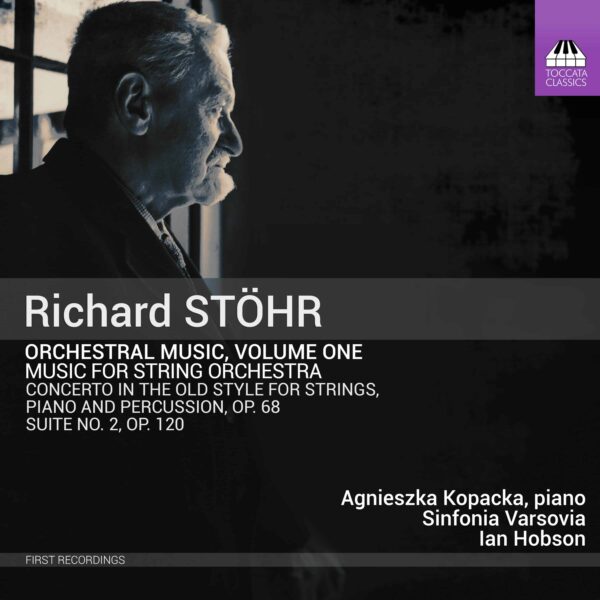Richard Stöhr: Orchestral Music, Volume Three
Like so many important Austrian musicians forced into American exile by the Nazis, Richard Stöhr (1874–1967) suddenly found himself cast from celebrity into obscurity, The optimism and energy, even defiance, of these three works from 1942 suggest that he took it in his stride, with his musical language retaining its Viennese accent in an individual amalgam of Bruckner, Mahler, Schmidt and Korngold. Indeed, the echoes of Mahler in Stöhr’s Second Symphony may be a deliberate homage if, as seems possible, this score is a revision of a now-lost work first composed shortly after Mahler’s death.
Sinfonia Varsovia
Ian Hobson, conductor
Listen To This Recording:
- Per Aspera as Astra: Festival Overture for Concert Band, Op. 79a (1942) (6:54)
- Two Roads to Victory (Through Arms – through Love): Musical Poem, Op. 79b (1942)
Symphony No. 2 in D minor, Op. 81 (1942) (38:13)
- I. Allegro energico (14:03)
- II. Andante (6:51)
- III. Vivace (7:40)
- IV. Allegro con fuoco (9:39)
First Recordings



Fanfare Magazine :
‘The [second] symphony displays imagination and creative energy, and is very much worth knowing.
Conductor Ian Hobson has been involved in all three volumes of Toccata’s orchestral Stöhr series, and he clearly believes in the music. These are much more than dutiful run-throughs. Well-balanced recorded sound and particularly good program notes complete the release. I look forward to more from Toccata in this series.’
—Henry Fogel, Fanfare Magazine, April 2025
Fanfare Magazine :
‘I can’t imagine Mahler fans not enjoying [Symphony no.2]. […]
There is much to savor in Stöhr’s Second Symphony, including a rousing, virtuosic finale that ties it all together and brings the work to a satisfying conclusion. […]
The always reliable Sinfonia Varsovia, originally founded in 1984 by Yehudi Menuhin, and the always dependable Ian Hobson, make fine work of Stöhr’s music. […]the symphony, especially, is an important addition to the repertoire of very late Romantic/post-Romantic symphonies, a significant contribution to Stöhr’s discography, and an invaluable aid in helping us understand this still largely unknown composer. ‘
—Jerry Dubins, Fanfare Magazine, April 2025
Fanfare Magazine :
‘[my respect for the conductor and the piani in the recording] is only augmented by the performances heard herein. […]
There is some really lovely writing [in Per aspera ad astra], and some of the tunes could well become earwigs for the listener. […]
I absolutely loved [this disc] from beginning to end, both in music and performance[…]. Richard Stöhr is as important composer as any who has been rescued from obscurity by Toccata. Anyone enamored of the Romantic symphonic tradition will want to acquire [this album]. […] This set will be a strong contender for my next Want List.’
—David DeBoor Canfield, Fanfare Magazine, April 2025
American Record Guide :
‘[Stöhr in his2nd movement of his symphony no.2,] in a movement less than 7 minutes long, Stohr covers a full range of textural and emotional interest. […]
Performances, conducting, and sound are all good.’
—Don O’Connor, American Record Guide, February 2025
Classical Music Daily :
‘[Two Roads to Victory] is actually an enjoyable and colourful piece. […]
The opening movement [of the second symphony] is quite grand and colourful, the musical themes are quite varied and the modulations often unexpected, but the structure is clear and the composer shows he is an adept orchestrator. […]
Again [the second] movement has some interesting modulations, well crafted orchestration and a clear structure. […]
There is much to enjoy in this colourful music [of the second symphony]. […]
Stöhr’s output is quite large, and if the symphony presented here is anything to go by, well worth a good listen. It is enjoyable and approachable. […] The orchestral playing by Sinfonia Varsovia and direction by Ian Hobson are excellent, and the accompanying booklet, like most of the Toccata Classics notes I have seen to date, is full and informative.’
—Geoff Pearce, Classical Music Daily
WTJU :
‘Stohr’s use of form is concise and well-organized. The music is large and expansive, but it always has a sense of direction. Stohr’s music was much admired by his students and his colleagues. And it’s easy to hear why. […]
Ian Hobson directs the Sinfonia Varsovia in some inspired performances. I especially enjoyed their performance of the Symphony No. 2. The ensemble makes it sound expansive and symphonic, yet also thoughtful and introspective. […]
Hobson understands Stohr very well. His recordings are helping us to understand him, too.’
—Ralph Graves, WTJU
Classical Lost and Found :
‘Once again, the album booklet has extensive details regarding his interesting life, as well as musical analyses of what’s here. […]
s on Toccata’s second volume of this composer’s orchestral music, the Warsaw based Sinfonia Varsovia (SinfaVars) under English conductor-pianist-teacher Ian Hobson (b. 1952) is again featured here. They deliver splendid accounts of all three selections, which will probably be definitive for some time to come. […]
The ones here present pragmatic sonic images in a pleasing venue, where there’s no feeling of that confinement frequently associated with “studio” recordings.’
—Robert E. McQuiston, Classical Lost and Found
Online Merker :
‘Mit der dritten Folge widmet sich Toccata Classics erneut der außergewöhnlichen Musik Richard Stöhrs und bringt dem Hörer drei kraftvolle Werke des Exilkomponisten aus dem Jahr 1942 nahe. Die Sinfonia Varsovia unter der Leitung von Ian Hobson entfaltet diese vergessenen Partituren mit Hingabe und betont dabei die zahlreichen Facetten der spätromantischen Ausdruckskraft. […]
Doch seine Musik, geprägt von Einflüssen Bruckners, Mahlers und Schmidts, bewahrte sich ihren unverwechselbar wienerischen Stil und Reichtum an Klangfarben. Die auf dieser CD eingespielten Werke, die in der schwierigen Zeit des zweiten Weltkriegs entstanden sind, strahlen eine künstlerische Kraft und einen ungebrochenen Optimismus aus.
Mit der Ouvertüre „Per Aspera ad Astra“ zeigt Stöhr seine kreative Experimentierfreude: Ungewöhnlich, kühn setzt er Saxophon und Klavier ein, die in der Besetzung der Sinfonia Varsovia in ihrer Konzert-Band-Konstellation farbig und klanglich reizvoll zur Geltung kommen. Hobson, der mit höchstem Respekt für die Nuancen des Werks dirigiert, nutzt diesen orchestralen Reichtum, um die dramatische Aussagekraft zu unterstreichen. Sein feines Gespür für Spannung bringt die heroische Reise „durch Widrigkeiten zu den Sternen“ zum Leuchten, und das Ensemble antwortet ihm mit einer Präzision und Spielfreude, die das eigenwillige Werk lebendig werden lässt.
Das musikalische Gedicht „Two Roads to Victory“ bringt erzeugt eine Welt voller Kontraste und entschiedener Klangfarben. Die Sinfonia Varsovia unter Hobsons Leitung entfaltet die dramatische Struktur der Partitur mit souveräner Klarheit. Die Musiker greifen die beiden gegensätzlichen Themen – den Weg des Krieges und den der Liebe – mit spürbarer Energie und Ausdruckskraft auf. Markante Akzente in den Blechbläsern und einprägsame Streicherpassagen geben der Komposition einen kraftvollen Zug, während Hobson das Ensemble in dynamischen Bögen führt, die die Dramatik und Emotionalität des Werks steigern. Besonders beeindruckend ist hier, wie die einzelnen Register zusammenfinden: Holz- und Blechbläser setzen prägnante Akzente, während die Streicher die emotionalen Facetten mit Schattierungen und Farben bereichern. Die Interpretation des Orchesters verleiht Stöhrs Vision damit eine klare, fast ergreifende Direktheit.
Der Höhepunkt der CD, die zweite Sinfonie in vier Sätzen, gibt Ian Hobson und der Sinfonia Varsovia Gelegenheit, ihr beeindruckendes Ausdrucksspektrum zu entfalten. Im ersten Satz meistern die Streicher und Holzbläser ein lebhaftes Wechselspiel, das die musikalischen Themen lebendig zur Geltung bringt. Hobson führt das Orchester mit feinem Gespür durch die dynamischen Spannungsbögen.
Der zweite Satz offenbart ein mystisches Spiel von Pizzicati und raunenden Bläserstimmen, in denen geheimnisvolle Harfeneinsprengsel für Momente funkelnder Schönheit sorgen. Hier zeigt sich die herausragende Fähigkeit der Sinfonia Varsovia, Klangfarben fein nuanciert zu gestalten und so eine dichte, beinahe magische Atmosphäre zu erschaffen. Hobson lenkt das Orchester mit Bedacht durch diese musikalische Szenerie, wobei er die verschiedenen Stimmen harmonisch ineinanderfließen lässt und die rätselhaften, fast schwebenden Momente raffiniert betont.
Der dritte Satz begeistert durch sein lebhaftes, keckes Thema, das in einem charmanten Dialog zwischen den Streichern und Blechbläsern umgesetzt wird. Hier bringt die Sinfonia Varsovia einen leichten, verspielten Charakter ein, der durch Hobsons lebendiges Dirigat noch verstärkt wird. Die Musik plappert fast wie in einem heiteren Gespräch und zeigt eine angenehme Gelöstheit.
Das Finale schließlich entfacht ein wahres Feuerwerk an musikalischer Kraft: Mit entfesselter Leidenschaft und stürmischem Ausdruck treibt Hobson das Ensemble zu einem kraftvollen Höhepunkt, in dem sich alle Register zu einem feurigen Ganzen vereinen. Die Sinfonia Varsovia zeigt hier eine bemerkenswerte Geschlossenheit und Energie.
Mit dieser Aufnahme setzen Ian Hobson und die Sinfonia Varsovia Richard Stöhr ein eindrucksvolles Denkmal. Sie haben das komplexe Werk des Komponisten mit höchster Sorgfalt und Musikalität erarbeitet und seine facettenreiche Tonsprache in all ihren Farben zum Leuchten gebracht. Diese Interpretation verleiht Stöhrs Musik Vitalität und öffnet ihm die Tür zurück in das Bewusstsein der Klassikliebhaber. Eine Entdeckung, die sich durch die hervorragende Leistung von Dirigent und Orchester auszeichnet und Musikfreunden, die auf der Suche nach besonderen Schätzen sind, wärmstens ans Herz gelegt sei!’
—Dirk Schauß, Online Merker
Online Merker :
‘With this third installment, Toccata Classics once again dedicates itself to the extraordinary music of Richard Stöhr, bringing listeners closer to three powerful works by the exiled composer from 1942. The Sinfonia Varsovia, under the direction of Ian Hobson, unfolds these forgotten scores with dedication, emphasizing the numerous facets of late Romantic expressiveness. […]
Yet his music, influenced by Bruckner, Mahler, and Schmidt, retained its distinctive Viennese style and richness of timbre. The works recorded on this CD, composed during the difficult period of World War II, radiate artistic power and unwavering optimism.
With the overture “Per Aspera ad Astra,” Stöhr demonstrates his creative joy of experimentation: he uses saxophone and piano in an unusual and bold manner, which, in the Sinfonia Varsovia’s concert band configuration, are colorfully and sonically appealingly showcased. Hobson, who conducts with the utmost respect for the work’s nuances, utilizes this orchestral richness to underscore its dramatic impact. His keen sense of tension illuminates the heroic journey “through adversity to the stars,” and the ensemble responds with a precision and joy that brings this idiosyncratic work to life.
The musical poem “Two Roads to Victory” creates a world full of contrasts and decisive timbres. Under Hobson’s direction, the Sinfonia Varsovia unfolds the score’s dramatic structure with sovereign clarity. The musicians address the two opposing themes—the path of war and the path of love—with palpable energy and expressiveness. Striking accents in the brass and memorable string passages give the composition a powerful thrust, while Hobson leads the ensemble in dynamic arcs that heighten the work’s drama and emotionality. Particularly impressive here is how the individual registers come together: woodwind and brass instruments set striking accents, while the strings enrich the emotional facets with nuances and colors. The orchestra’s interpretation thus lends Stöhr’s vision a clear, almost moving directness.
The climax of the CD, the second symphony in four movements, gives Ian Hobson and the Sinfonia Varsovia the opportunity to unfold their impressive expressive range. In the first movement, the strings and woodwinds master a lively interplay that vividly brings the musical themes to life. Hobson guides the orchestra with a fine sense of sensitivity through the dynamic arcs of tension.
The second movement reveals a mystical interplay of pizzicatos and whispering wind parts, in which mysterious harp interludes provide moments of sparkling beauty. This showcases the Sinfonia Varsovia’s outstanding ability to create finely nuanced timbres, thus creating a dense, almost magical atmosphere. Hobson guides the orchestra carefully through this musical scenery, allowing the various voices to flow harmoniously into one another and subtly accentuating the enigmatic, almost suspended moments.
The third movement captivates with its lively, bold theme, realized in a charming dialogue between the strings and brass. Here, the Sinfonia Varsovia brings a light, playful character, further enhanced by Hobson’s lively conducting. The music chatters almost like a cheerful conversation and displays a pleasant sense of ease.
The finale ignites a true firework of musical power: With unleashed passion and tempestuous expression, Hobson drives the ensemble to a powerful climax in which all registers unite into a fiery whole. The Sinfonia Varsovia demonstrates remarkable cohesion and energy here.
With this recording, Ian Hobson and the Sinfonia Varsovia create an impressive tribute to Richard Stöhr. They have explored the composer’s complex work with the utmost care and musicality, bringing his multifaceted musical language to life in all its rich colors. This interpretation breathes vitality into Stöhr’s music and opens the door back into the consciousness of classical music lovers. A discovery distinguished by the outstanding performance of both conductor and orchestra, it is warmly recommended to music lovers seeking special treasures!’
—Dirk Schauß, Online Merker